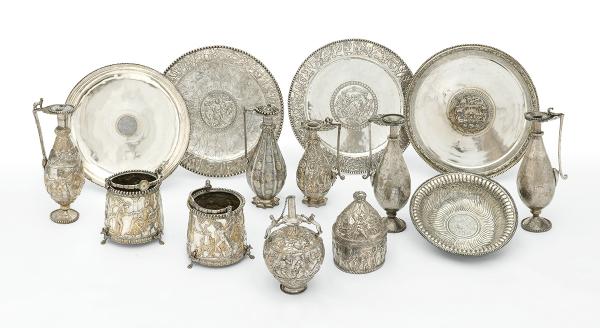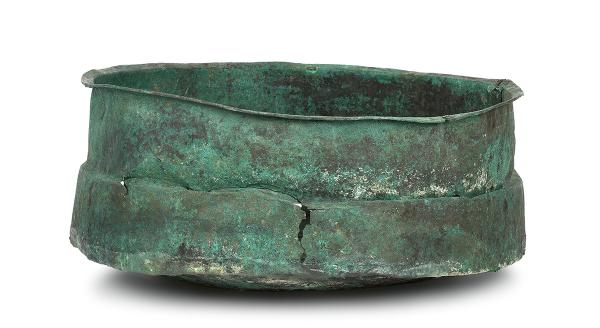The treasure
The Seuso treasure originates from the late imperial period of the Roman Empire (4th – 5th centuries). It was named after its owner, Seuso, whose name appears in the inscription of the so-called hunting or Seuso platter. Its pieces are characteristic elements of a dining set used for feasts, while vessels for washing and beautification are also included. Probably in the last decades of the 4th or the beginning of the 5th century, the treasure was hidden by its owner, who was most likely fleeing from a war conflict.
The set known today consists of fourteen large silver vessels, made in the 4th century, and a copper cauldron, in which the silver vessels were hidden.
Of the roughly thirty precious metal hoards containing pieces of dining and toiletry sets and dated to the late Roman period, the Seuso treasure occupies an outstanding place regarding both its artistic and material value.
Considering its total weight, it is regarded as the most valuable silversmith treasure find to survive from the late Roman period.
The Seuso treasure was found in the 1970s. Since then it has experienced numerous turns of fortune and it remained hidden from the public eye for several decades. As a result of a long series of negotiations, the Hungarian state managed to success-fully repatriate the currently known 15 pieces of the treasure in 2014 and 2017. Thus the public can now freely admire this late imperial treasure of outstanding artistic quality.
The Seuso treasure consists of two large, flat platters used as serving dishes, two further platters for serving and presumably also for display, a deep basin for washing with two ewers decorated with geometric motifs, and a further three ewers, one with Dionysiac depictions, another with animal figures and the third with Greek mythological representations. Two situlae (buckets), a toilet casket for storing perfume or ointment pots and an amphora also belong to the treasure. The silver vessels were concealed in a copper cauldron of 83 cm in diameter and 32.5 cm in height, in such a way that the large platters were laid turned down-wards on top of one another at the bottom of the cauldron with the smaller vessels placed on top. The treasure is probably not complete.
Judging by other similar treasure finds and banquet representations, it could have included further pieces, such as a stand, smaller tableware, eating utensils and drinking vessels.
Their current location, if they actually existed, is unknown. The silver vessels can all be characterised by the high purity of their silver (91–99 %) and their ostentatious size and weight, which places them among the largest known Roman silver vessels. The total weight of the treasure’s silver vessels is 68.5 kilograms. Near the presumed site where the treasure was discovered, fragments of a late Roman silver stand were found at Kőszárhegy in 1878. On the basis of its place of discovery, value and decoration, the stand, which originally in its complete state weighed 20 kilograms, probably had been part of the Seuso set.



